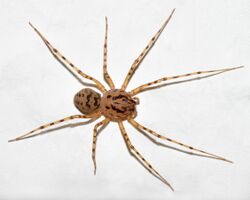Biology:Scytodes
This article includes a list of general references, but it remains largely unverified because it lacks sufficient corresponding inline citations. (December 2020) (Learn how and when to remove this template message) |
| Scytodes | |
|---|---|

| |
| Scytodes thoracica | |
| Scientific classification | |
| Domain: | Eukaryota |
| Kingdom: | Animalia |
| Phylum: | Arthropoda |
| Subphylum: | Chelicerata |
| Class: | Arachnida |
| Order: | Araneae |
| Infraorder: | Araneomorphae |
| Family: | Scytodidae |
| Genus: | Scytodes Latreille, 1804[1] |
| Type species | |
| Scytodes thoracica (Latreille, 1802)
| |
| Species | |
|
220, see text | |
Scytodes is a genus of spitting spiders that occur all around the world. The most widely distributed species is Scytodes thoracica, which originally had a palearctic distribution, but has been introduced to North America, Argentina, India, Australia, and New Zealand.[1] The genus was first described by Pierre André Latreille in 1804.[2] Spitting spiders have pale yellow bodies with black spots on their cephalothorax, and legs that are characterized by black bands.
Behavior
Reproduction
Scytodes species are typically solitary until mating or hunting due to their aggressive nature. Males are cautious when trying to find a mate. Females carry their eggs until they hatch, typically under their body or in their chelicerae. This is the most vulnerable stage in life, the egg-carrying period. Upon hatching, the juvenile spiders remain in their mother's web. They cooperatively capture and feed on prey caught in the web. Upon reaching sexual maturity, the young spiders leave the web, move a short distance away and exhibit solitary behavior.[3] The genus exhibits sexual dimorphism, males range in size from 3.5 to 4 mm while females are slightly larger ranging from 4 to 4.5 mm. These spiders do not die post-mating; males live 1.5–2 years and females live 2 to 4 years.
Spitting
The spitting from which its name derives is used as a method of trapping prey[4] or escaping predators.[5] Sticky gum is expelled from their fangs and can be shot up to ten body lengths from the spider.[4] When the string of venomous substance is shot, anywhere from 5 to 17 parallel overlapping bands cover the meal and kill it.
Species
(As of November 2022) Scytodes contains 219 species and 1 subspecies. Spitting spiders often are found in temperate and terrestrial habitat regions such as forests in South America, the Caribbean, Central America, Africa, Europe, Asia, North America, Oceania, and on the Pacific Islands:.[1] In the presence of humans, these spiders are found in dark corners, cellars, cupboards, and closets of houses.
References
- ↑ 1.0 1.1 1.2 Gen. Scytodes Latreille, 1804. Natural History Museum Bern. 2020. doi:10.24436/2. http://www.wsc.nmbe.ch/genus/3070. Retrieved 2020-07-07.
- ↑ Latreille, P. A. (1804). "Tableau methodique des Insectes". Nouveau Dictionnaire d'Histoire Naturelle, Paris 24: 129–295.
- ↑ Li, Daiqin; Jackson, Robert R.; Barrion, Alberto T. (March 1999). "Parental and predatory behaviour of Scytodes sp., an araneophagic spitting spider (Araneae: Scytodidae) from the Philippines". Journal of Zoology 247 (3): 293–310. doi:10.1111/j.1469-7998.1999.tb00993.x.
- ↑ 4.0 4.1 McAlister, W. (1960). "The spitting habit in the spider Scytodes intricate Banks (Family Scytodidae)". Texas Journal of Science 12: 17–20.
- ↑ Gilbert, C.; Rayor, L.S. (1985). "Predatory behavior of spitting spiders (Araneae: Scytodidae) and the evolution of prey wrapping". Journal of Arachnology 13: 231–241. http://www.americanarachnology.org/JoA_free/JoA_v13_n2/JoA_v13_p231.pdf. Retrieved 24 May 2018.
- Scytodes, Animal Diversity, 2014
- Suter, Robert (2009), "Spitting Performance Parameters and Their Biomechanical Implications in the Spitting Spider, Scytodes", Journal of Insect Science 9: 1–15, doi:10.1673/031.009.6201, PMID 20050781
- Belosludtsev, E.A.; Gasilin, V.V. (2018), "Cosmopolitan Distribution of the Spitting Spider Scytodes thoracica Latreille, 1802 (Aranei, Scytodidae) and Its New Findings in the Northern Parts of the Range", Contemporary Problems of Ecology 11 (2): 123–136, doi:10.1134/S1995425518020038
Wikidata ☰ Q2248809 entry
 |



